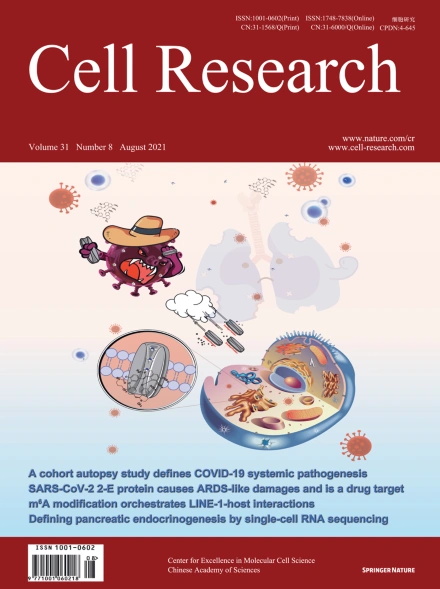
Advanced Search
Submit Manuscript
Advanced Search
Submit Manuscript
Volume 31, No 8, Aug 2021
ISSN: 1001-0602
EISSN: 1748-7838 2018
impact factor 17.848*
(Clarivate Analytics, 2019)
Volume 31 Issue 8, August 2021: 847-860 |
SARS-CoV-2 envelope protein causes acute respiratory distress syndrome (ARDS)-like pathological damages and constitutes an antiviral target
Bingqing Xia1,2 , Xurui Shen1,2 , Yang He1,2 , Xiaoyan Pan3 , Feng-Liang Liu4 , Yi Wang1,2 , Feipu Yang1,2 , Sui Fang1 , Yan Wu3 , Zilei Duan4 , Xiaoli Zuo1 , Zhuqing Xie1,5 , Xiangrui Jiang1,2 , Ling Xu4 , Hao Chi1,2 , Shuangqu Li1,2 , Qian Meng1 , Hu Zhou1,2 , Yubo Zhou1,2 , Xi Cheng1,2 , Xiaoming Xin5 , Lin Jin4 , Hai-Lin Zhang6 , Dan-Dan Yu4 , Ming-Hua Li7 , Xiao-Li Feng7 , Jiekai Chen8,9,10 , Hualiang Jiang1,2 , Gengfu Xiao3 , Yong-Tang Zheng4,7,* , Lei-Ke Zhang3,* , Jingshan Shen1,2,* , Jia Li1,2,11,* , Zhaobing Gao1,2,11,12,*
1CAS Key Laboratory of Receptor Research, Stake Key Laboratory of Drug Research, Shanghai Institute of Materia Medica, Chinese Academy of Sciences, Shanghai, ChinaCytokine storm and multi-organ failure are the main causes of SARS-CoV-2-related death. However, the origin of excessive damages caused by SARS-CoV-2 remains largely unknown. Here we show that the SARS-CoV-2 envelope (2-E) protein alone is able to cause acute respiratory distress syndrome (ARDS)-like damages in vitro and in vivo. 2-E proteins were found to form a type of pH-sensitive cation channels in bilayer lipid membranes. As observed in SARS-CoV-2-infected cells, heterologous expression of 2-E channels induced rapid cell death in various susceptible cell types and robust secretion of cytokines and chemokines in macrophages. Intravenous administration of purified 2-E protein into mice caused ARDS-like pathological damages in lung and spleen. A dominant negative mutation lowering 2-E channel activity attenuated cell death and SARS-CoV-2 production. Newly identified channel inhibitors exhibited potent anti-SARS-CoV-2 activity and excellent cell protective activity in vitro and these activities were positively correlated with inhibition of 2-E channel. Importantly, prophylactic and therapeutic administration of the channel inhibitor effectively reduced both the viral load and secretion of inflammation cytokines in lungs of SARS-CoV-2-infected transgenic mice expressing human angiotensin-converting enzyme 2 (hACE-2). Our study supports that 2-E is a promising drug target against SARS-CoV-2.
https://doi.org/10.1038/s41422-021-00519-4